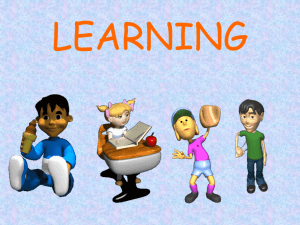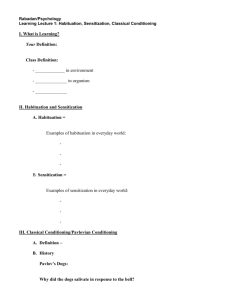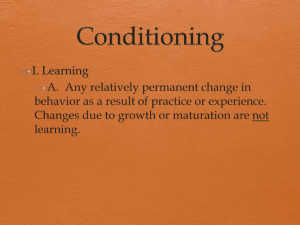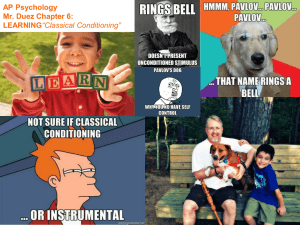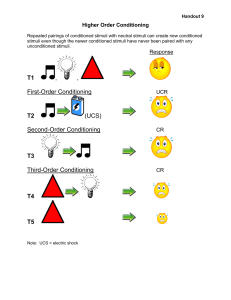CLASSICAL-CONDITIONING- Julian
advertisement
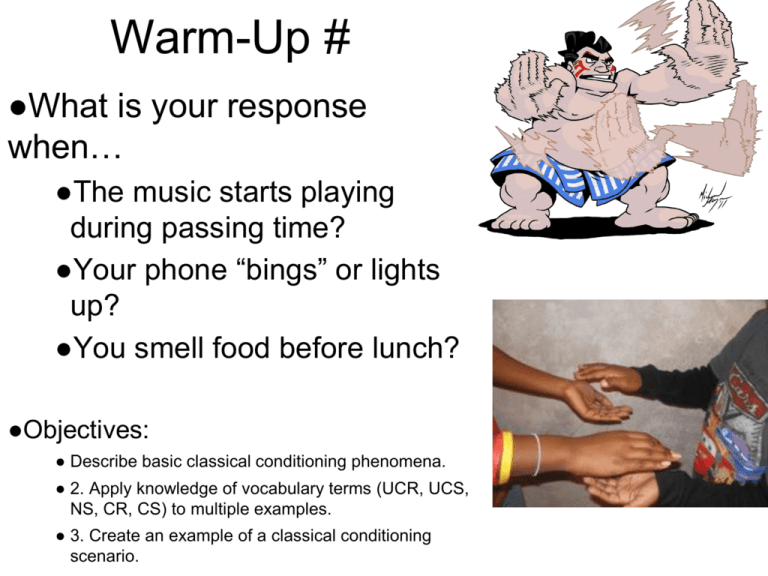
Warm-Up # ●What is your response when… ●The music starts playing during passing time? ●Your phone “bings” or lights up? ●You smell food before lunch? ●Objectives: ● Describe basic classical conditioning phenomena. ● 2. Apply knowledge of vocabulary terms (UCR, UCS, NS, CR, CS) to multiple examples. ● 3. Create an example of a classical conditioning scenario. Psychology I Julian “Classical Conditioning” What is Learning? Most learning is... Associative Learning: Realization that certain events occur together. Learning itself refers to a relatively durable change in behavior or knowledge that is due to experience. ★ Classical Conditioning ★ Operant Conditioning ★ Observational Learning (Latent, Abstract, Insight) Classical Conditioning Ivan Pavlov developed the framework for CC: Learning to associate one stimulus with another, i.e. “Stimulus-to-Stimulus Learning” “Next time there is a revolution, get up earlier!” How is the fear of lightning a simple classical conditioning situation? At any one time, all around the world, there are 2,000 thunderstorms happening, producing over a 100 lightning strikes a second. That's over 8 million lightning bolts every day unleashing the power of 2 million tons of TNT. We associate 2 stimuli: We see lightning... & then hear thunder. (speed of light is faster than the speed of sound) Lightning ... THUNDER Lightning ... THUNDER Lightning ... THUNDER Eventually, you see lightning and then flinch... anticipating the second stimulus. You have paired lightning & thunder. And you have learned that when there is lightning, thunder may follow. We associate 2 stimuli: We see lightning... & then hear thunder. (speed of light is faster than the speed of sound) Lightning ... THUNDER Lightning ... THUNDER Lightning ... THUNDER Eventually, you see lightning and then flinch... anticipating the second stimulus. You have paired lightning & thunder. And you have learned that when there is lightning, thunder may follow. Annenberg: Discovering Psychology: Program 8 - Learning. Unconditioned Stimulus (UCS): a stimulus that naturally & automatically triggers a response. Unconditioned Response (UCR): the unlearned, naturally occurring response to the UCS. Conditioned Stimulus (CS): an originally irrelevant stimulus that, after association with the UCS, comes to trigger a response. Conditioned Response (CR): the learned response to a previously neutral stimulus. We associate 2 stimuli: We see lightning... & then hear thunder. (speed of light is faster than the speed of sound) Lightning ... THUNDER Lightning ... THUNDER Lightning ... THUNDER Eventually, you see lightning & then flinch... anticipating the second stimulus. You have paired lightning & thunder. And you have learned that when there is lightning, thunder may follow. UCS: ? UCR: ? NS: ? CS: ? CR: ? After repeated episodes.... creating ‘Conditioning’: UCS: Thunder UCR: Fear NS: Lightning CS: Lightning CR: Fear YouTube: Students Try Classical Conditioning... I think UCS UCR NS CS CR - Jumping & Scaring the dog Dog is fearful Bell Sound Bell Sound Dog is fearful YouTube: The Office - Classical Conditioning Jim asks, 'Do you want an altoid?' Dwight reaches out his hand. Computer tone Computer tone Dwight reaches out his hand. ...UCS ...UCR ...NS ...CS ...CR Pair up with your shoulder buddy. Create an example of a possible Classical Conditioning experiment. Write out your hypothesis. Then write out each of your variables. We will present them to the class for discussion. UCS - Unconditioned Stimulus UCR - Unconditioned Response NS - Neutral Stimulus CS - Conditioned Stimulus CR - Conditioned Response Think of an experiment that you could do that would be similar to those examples of the Pavlov, Dwight, Frazier, and the student example. Double check the class examples with this chart for accuracy... ___________________ -> _________________ UCS UCR ___________________ -> NS NO RESPONSE __________ + ________ -> _________________ NS UCR UCS ____________________ -> _________________ CS CR Stop! Next: Acquisition and Generalization Pavlov spent the rest of his life outlining his ideas. He discovered 5 critical terms that together make up classical conditioning: ★ Acquisition ★ Extinction ★ Spontaneous Recovery ★ Generalization ★ Discrimination Acquisition The initial stage of learning. The phase where the neutral stimulus is associated with the UCS Therefore the neutral stimulus comes to elicit the CR, thus becoming the CS. Does timing matter? The CS should come before the UCS They should be very close together in timing. Extinction The diminishing of a conditioned response. Will eventually happen when the UCS does not follow the CS. Is extinction permanent? Spontaneous Recovery Reappearance. After a rest period, of an extinguished conditioned response, the conditioned response returns. Generalization The tendency, once a response has been conditioned, for stimuli similar to the CS to elicit similar responses. Stimulus generalization from a circle to an ellipse: Dogs also would salivate to the sight of an ellipse. Thus, for these dogs, the CR of salivation to the sight of a circle showed stimulus generalization to the ellipse ( Shenger-Krestovnika, 1921) The classical conditioning theory of phobic disorder states that the learned fear to a CS generalizes (transfers) to other stimuli, with the greatest amount of transfer occurring to stimuli that are most similar to the CS. Discrimination The learned ability to distinguish between a CS and other stimuli that does not signal UCS. As described on the last slide, dogs showed stimulus generalization to the sight of an ellipse when they had been classically conditioned to salivate to the sight of a circle. If one continued to pair the circle with meat but never paired the ellipse with meat. Over time, the dogs stopped salivating to the ellipse but continued to salivate to the circle. That is, the dogs were able to discriminate between the ellipse and the circle, and learned that they received meat only after seeing the circle (ShengerKrestovnika, 1921) Classical conditioning theory of phobic disorder: individuals learn to discriminate between a CS that is followed reliably by a fear-inducing UCS & stimuli that, although similar, are rarely or never followed by the UCS. For example, in the case of the dog that is fearful of all men because it has been treated cruelly by a particular man, it probably will learn to feel fear only to the man who abused it if most other men the dog meets treat it kindly. Difference between Stimulus Generalization & Discrimination How would you define stimulus generalization in your own words? How would you define stimulus discrimination in your own words? John B. Watson - Classical Conditioning Founder of Behaviorism. Took Pavlov’s ideas and put them to new & more rigorous tests. “Little Albert” & Generalization Watson demonstrated that he could create fear in a child in response to a neutral stimulus (a rat). Paired a rat with a fear-inducing stimulus (a loud noise), the child eventually became fearful of related stimuli = Generalization YouTube: Little Albert Footage UCS - Loud Noise UCR - Fear, crying, madness, NS - misery CS - Rat CR - Rat Fear Credit to: Welle's Wacky World of Psychology A Blog for Psychology Students, Enthusiasts, & the Crazy John B. Watson in his experiment with Little Albert, an 11 month old baby, studied how emotions are learned. He presented a white rat (NS) & a loud noise (UCS) to Little Albert. After several pairings, Albert showed fear (CR) of the white rat. Later, Albert generalized the fear to stimuli that were similar to CS, such as a beard. After conditioning… Is this study ethical? Experiments should not cause human participants to suffer unnecessary distress or be physically harmed. Welfare of human participants must always be the paramount consideration in any form of research, & this is especially true with specially protected groups such as children.
